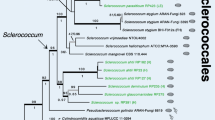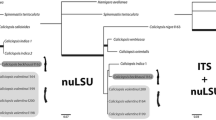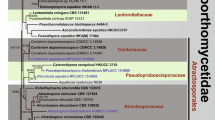Abstract
Detailed morphological investigations and phylogenetic analyses of the ITS/5.8S nrDNA reveal Umbilicaria caroliniana to be a member of Lasallia. A new combination, Lasallia caroliniana (Tuck.) Davydov, Peršoh & Rambold comb. nov., is proposed. The circumscription of Lasallia is extended by the character state of eight-spored asci. According to the new concept, Lasallia is distinguished from Umbilicaria by comprising species which combine large, multicellular, brown ascospores and a pustulate thallus. The functionally significant differences in ascospore morphology justify the current division of Umbilicariaceae into Lasallia and Umbilicaria, although Umbilicaria remains paraphyletic.



Similar content being viewed by others
References
Brodo IM, Duran Sharnoff S, Sharnoff S (2001) Lichens of North America, New Haven
Brummitt RK (2003) Further dogged defense of paraphyletic taxa. Taxon 52:803–804
Brummitt RK (2006) Am I a bony fish? Taxon 55:268–269
Davydov EA (2007) Approaches to a classification of the family Umbilicariaceae (lichenised Ascomycota) by anatomical and morphological characters. Turczaninowia 10(3–4):51–57
Dias P, Assis LCS, Udulutsch RG (2005) Monophyly vs. paraphyly in plant systematics. Taxon 54:1039–1040
Ebach MC, Williams DM, Morrone JJ (2006) Paraphyly is bad taxonomy. Taxon 55:831–832
Elenkin AA, Savicz VP (1910) Enumeratio lichenum in Sibiria orientali a cl. I. Sczegolev anno 1903 lectorum. Trav Mus Bot Acad Imp Sci St.-Pétersbourg. Livr 8:26–49
Frey E (1931) Weitere Beiträge zur Kenntnis der Umbilicariaceen. Hedwigia 71:94–119
Frey E (1933) Cladoniaceae (unter Ausschluß d. Gatt. Cladonia), Umbilicariaceae. In Dr. L. Rabenhorst’s Kryptogamenflora von Deutschland, Österreich und der Schweiz, Bd. 9. Leipzig, pp 1–426
Ivanova NV, DePriest PT, Bobrova VK, Troitsky AV (1999) Phylogenetic analysis of the lichen family Umbilicariaceae based on nuclear ITS1 and ITS2 rDNA sequences. Lichenologist 31(5):477–489
Lindau G (1899) Beiträge zur Kenntnis der Gattung Gyrophora. In Festschrift für Schwendener. Berlin, pp 19–36
Llano GA (1950) A monograph of the lichen family Umbilicariaceae in the Western Hemisphere. Washington
Miadlikowska J, Kauff F, Hofstetter V, Fraker E, Grube M, Hafellner J, Reeb V, Hodkinson BP, Kukwa M, Lücking R, Hestmark G, Otalora MG, Rauhut A, Büdel B, Scheidegger C, Timdal E, Stenroos S, Brodo I, Perlmutter GB, Ertz D, Diederich P, Lendemer JC, May P, Schoch CL, Arnold AE, Gueidan C, Tripp E, Yahr R, Robertson C, Lutzoni F (2006) New insights into classification and evolution of the Lecanoromycetes (Pezizomycotina, Ascomycota) from phylogenetic analyses of three ribosomal RNA- and two protein-coding genes. Mycologia 98:1088–1103
Minks A (1900) Analysis der Flechtengattung Umbilicaria. Zugleich ein lichenologischer Beitrag zur Kenntnis der Entstehung und des Begriffes der naturwissenschaftlichen Art. Mémoires de l'Herbier Boissier 22:1–77
Narui T, Culberson CF, Culberson WL, Johnson A, Shibata S (1996) A contribution to the chemistry of the lichen family Umbilicariaceae (Ascomycotina). Bryologist 99(2):199–211
Nordal I, Stedje B (2005) Paraphyletic taxa should be accepted. Taxon 54:5–6
Peršoh D, Rambold G (2002) Phacopsis–a lichenicolous genus of the family Parmeliaceae. Mycol Progr 1(1):43–55
Poelt J (1962) Bestimmungsschlüssel der höheren Flechten von Europa. Mitt Bot Staatssammlung München 4:301–571
Potter D, Freudenstein JV (2005) Character-based phylogenetic Linnaean classification: taxa should be both ranked and monophyletic. Taxon 54:1033–1035
Rambold G, Meier C, Thamerus M (1998) A comparative study on structure and functionality of asci in species of Rhizocarpon (Lecanorales, Ascomycetes). Cryptogam, Bryol-Lichénole 19(2–3):247–255
Read ND, Becket A (1996) Ascus and ascospore morphogenesis. Mycol Res 100(11):1281–1314
Savicz VP (1950) Conspectus lichenum ad flora Umbilicariacearum in URSS. Notulae System. e Sect Cryptogamica Inst Bot nomine VL Komarovii Acad Sci URSS 6(7–12):97–108
Scholander PF (1934) On the apothecia in the lichen family Umbilicariaceae. Nytt Magazin for Naturvidenskaberne 75:1–32
Stamatakis A (2006) RAxML-VI-HPC: maximum likelihood-based phylogenetic analyses with thousands of taxa and mixed models. Bioinformatics 22:2688–2690
Tuckerman E (1877) Observationes lichenologicae No. 4. Observations on North American and other lichens. Proc Am Acad Arts Sci 12:166–185
Tuckerman E (1882) A synopsis of the North American lichens. Part. I, comprising the Parmeliacei, Cladoniei and Coenogoniei. Boston
Vei JC [= Wei JC] (1966) A new subgenus of Lasallia Mérat emend. Vej. Acta Phytotaxonom Sin 11 (1):1–8
Wei JC, Jiang YM (1993) The Asian Umbilicariaceae (Ascomycota). Mycrosyst Monograph Ser No. 1. Beijin
Williams DM, Ebach MC, Wheeler QD (2005) 150 reasons for paraphyly: a response. Taxon 54:858
Zahlbruckner A (1926) Lichenes (Spezieller Teil). In Engler A, Prantl K (eds) Die natürlichen Pflanzenfamilien. Leipzig, pp 61–270
Zahlbruckner A (1927) Addidamenta ad Lichenographiam Japoniae. Bot Mag Tokyo 41(484):313–364
Zander RH (2007) Paraphyly and the species concept, a reply to Ebach & al. Taxon 56(3):642–644
Acknowledgements
We thank the curators of FH, LE, VLA, and PIG RAS for the loan of material, and the colleagues, who kindly provided additional specimens. John A. Elix (Canberra) is thanked for correcting the English and Christina Leistner (Bayreuth) for assistance with the laboratory work. The first author was supported by DAAD (German Academic Exchange Service) no. A/03/01054, by the Grants of President of Russian Federation no. MK 5671.2006.4, and of Russian Foundation of Basic Research no. 07-04-90800 and no. 09-04-90703.
Author information
Authors and Affiliations
Corresponding author
Rights and permissions
About this article
Cite this article
Davydov, E.A., Peršoh, D. & Rambold, G. The systematic position of Lasallia caroliniana (Tuck.) Davydov, Peršoh & Rambold comb. nova and considerations on the generic concept of Lasallia (Umbilicariaceae, Ascomycota). Mycol Progress 9, 261–266 (2010). https://doi.org/10.1007/s11557-009-0636-y
Received:
Revised:
Accepted:
Published:
Issue Date:
DOI: https://doi.org/10.1007/s11557-009-0636-y




